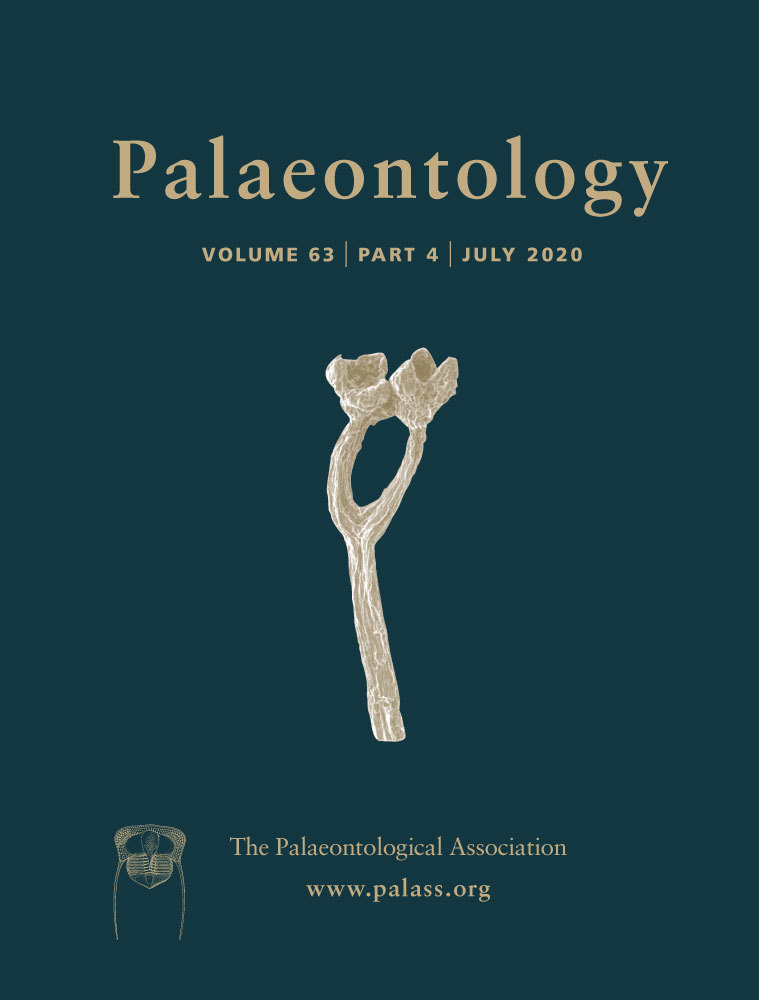Pelagiella exigua, an early Cambrian stem gastropod with chaetae: lophotrochozoan heritage and conchiferan novelty
Data archiving statement
Keys identifying individual numbered specimens on the part-and-counterpart slab USNM 617253p and 617253cp and some additional photographs are available in the Dryad Digital Depository: https://doi.org/10.5061/dryad.5tb2rbp0q.
This published work has been registered in ZooBank: http://zoobank.org/References/7804929D-2EF1-4396-A206-3F614DE6B65A
Abstract
Exceptionally well-preserved impressions of two bundles of bristles protrude from the apertures of small, spiral shells of Pelagiella exigua, recovered from the Kinzers Formation (Cambrian, Stage 4, ‘Olenellus Zone’, c. 512 Ma) of Pennsylvania. These impressions are inferred to represent clusters of chitinous chaetae, comparable to those borne by annelid parapodia and some larval brachiopods. They provide an affirmative test in the early metazoan fossil record of the inference, from phylogenetic analyses of living taxa, that chitinous chaetae are a shared early attribute of the Lophotrochozoa. Shells of Pelagiella exhibit logarithmic spiral growth, microstructural fabrics, distinctive external sculptures and muscle scars characteristic of molluscs. Hence, Pelagiella has been regarded as a stem mollusc, a helcionelloid expressing partial torsion, an untorted paragastropod, or a fully torted basal member of the gastropod crown group. The inference that its chaeta-bearing appendages were anterior–lateral, based on their probable functions, prompts a new reconstruction of the anatomy of Pelagiella, with a mainly anterior mantle cavity. Under this hypothesis, two lateral–dorsal grooves, uniquely preserved in Pelagiella atlantoides, are interpreted as sites of attachment for a long left ctenidium and a short one, anteriorly on the right. The orientation of Pelagiella and the asymmetry of its gills, comparable to features of several living vetigastropods, nominate it as the earliest fossil mollusc known to exhibit evidence of the developmental torsion characteristic of gastropods. This key adaptation facilitated an evolutionary radiation, slow at first and rapid during the Ordovician, that gave rise to the remarkable diversification of the Gastropoda.
Dextrally coiled pelagiellids, globally distributed in early to mid-Cambrian assemblages of small shelly fossils, are among the best known of the early conchiferans. Their tiny shells (mostly 1–2 mm across, but Pelagiella atlantoides (Matthew, 1895a) reached 9 mm) expand asymmetrically away from the plane of the first whorl, down the spiral axis, then back upward to establish an adult form that is almost planispiral, with a depressed apex (Fig. 1). They have been treated implicitly or explicitly as stem group conchiferans (Peel 1991; Wagner 2002; Frýda et al. 2008; Zhao et al. 2017), as untorted helcionelloids (Runnegar 1981; regarded at that time as monoplacophorans) and explicitly as gastropods presumed to have undergone torsion during their development (Pojeta & Runnegar 1976; Parkhaev 2001a, 2008; Landing et al. 2002). Recently, together with the aldanellids, they have been linked erroneously to the Hyolitha (Dzik & Mazurek 2013).
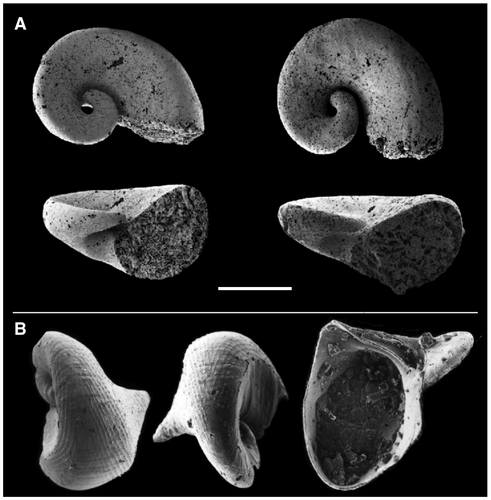
In this paper, we report the discovery, in the Kinzers Formation of south-eastern Pennsylvania, of numerous specimens of Pelagiella exigua Resser & Howell, 1938 with associated impressions of two clusters of chaetae (Fig. 2). The occurrence of a pair of chaeta-bearing appendages, inferred to have extended from the anterior body wall or foot of the animal, is unique among molluscs, living and extinct. Moreover, chitinous chaetae, characteristic of annelids and brachiopods, have been cited as a homologous feature of lophotrochozoans, so the occurrence in the fossil record of an early conchiferan with chaetae has phylogenetic implications. We document the new material in detail, assessing its implications for the anatomy of Pelagiella, its likely mode of life, and its potential role in the emergence of the Gastropoda.
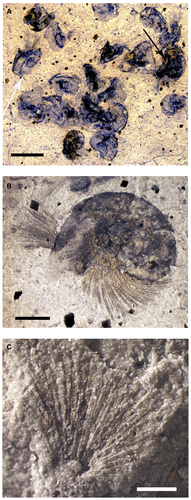
Lophotrochozoans are protostomes, united as a clade by the results of molecular phylogenetic analyses (Halanych et al. 1995; Kocot et al. 2011). Their shared morphological characters are limited mainly to features of their embryos and larvae (Halanych 2004). Phylogenetic studies recognize a subsidiary trochozoan clade, including annelids, brachiopods and molluscs (Dunn et al. 2008; Laumer et al. 2015), in which chitinous chaetae appear to be a common ancestral character (Dunn et al. 2008; Giribet, 2008; Schiemann et al. 2017). In the Mollusca, chaetae may have been lost among taxa assigned to the Aculifera and, once or repeatedly, in diversification of the Conchifera (Zakrzewski 2011) during the Cambrian Explosion (535–515 Ma). Alternatively, chaetae may have been retained by the aculiferans, if the chitinous cores of their calcareous sclerites are indeed homologous with chaetae (Scheltema 1993; Vinther 2015), but generally not in the Conchifera.
Relationships among the molluscan classes have yet to be fully resolved, probably in part because their evolutionary radiation was so rapid (Runnegar & Pojeta 1974; Sigwart & Lindberg 2015; Vinther 2015; Wanninger & Wollesen 2019). The advent of molecular phylogenetics raised the hope that these long-standing difficulties would be overcome. Recently, a near-consensus emerged on the view, anticipated by Scheltema (1993), that the molluscs evolved to constitute two major clades, the Aculifera and the Conchifera (Kocot et al. 2011; Smith et al. 2011; Vinther 2014). Subsequently, very different phylogenetic relationships have been inferred from comparison of numerous published molluscan trees (Sigwart & Lindberg 2015), and from time-calibrated phylogenetic analysis of a more broadly representative molluscan data set (Stöger et al. 2013) that posits gastropods as the sister group of a clade including bivalves and Serialia (= Monoplacophora + Polyplacophora). From a different perspective, privileging the hypothesis that a U-shaped gut may be homologous among lophotrochozoans, Budd & Jackson (2016) have revived the link between gastropods and cephalopods, as Cyrtosoma. However, the relationships proposed by these authors differ from both the phylogeny proposed by Stöger et al. (2013) and from the Cyrtosoma–Diasoma dichotomy as it was defined by Runnegar & Pojeta (1974).
We have framed our assessment of Pelagiella in terms of the Aculifera–Conchifera paradigm, which has been widely adopted (Wollesen et al. 2018; Kocot et al. 2019; Wanninger & Wollesen 2019). If this view is largely correct, the diversification of molluscan taxa reflects the adoption of markedly different modes of skeletal evolution and development characterizing the two major clades. Among early fossil molluscs, stem group aculiferans, almost certainly including Calvapilosa (Vinther et al. 2017) and more controversially Halkieria (Vinther & Nielsen 2005; Caron et al. 2006), Sinosachites (Vinther 2009) and Orthrozanclus (Conway Morris & Caron 2007; Zhao et al. 2017), evolved scleritomes consisting of discrete, more or less varied and integrated elements, secreted across a broad mantle field. In contrast, mostly diminutive cap or cone shaped small shelly fossils, including Pelagiella, represent continuous, logarithmically expanding, univalve or bivalve skeletons of organisms from which the familiar shell bearing classes of the Conchifera are inferred to have evolved (Pojeta & Runnegar 1976; Bengtson 1992; Runnegar 1996; Vendrasco 2012). Now, we show that Pelagiella was both an innovator in the differentiation of these classes and, given its chaetae, the bearer of a deeply rooted feature of its lophotrochozoan ancestry.
Faunal, stratigraphical and palaeoenvironmental context
Olenellid trilobites and associated early Cambrian shelly fossils have been known from the Kinzers Formation of Lancaster and York counties, Pennsylvania, USA, for well over 100 years (Walcott 1896, 1910). Discovery of antennae attached to the type specimen of Olenellus getzi Dunbar, 1925 and later recovery of algae, parts of lightly sclerotized exoskeletons of arthropods (notably Anomalocaris and Tuzoia) and other soft-bodied organisms (Resser 1929; Resser & Howell 1938), as well as novel echinoderms (Foerste 1938; Durham 1966; Sprinkle 1973), confirmed the modest but significant role of Kinzers Lagerstätten and associated faunas in documenting the sequential development of the ‘Cambrian Explosion’ of metazoans (Holmes et al. 2018).
The Kinzers Formation accumulated during the second cycle of early Cambrian transgression of the Iapetus Ocean onto Laurentia. Paralleling the regional strike of the Appalachians (Fig. 3), it consists largely of limestone, inferred from widespread submarine debris flows to have accumulated in outer shelf and deeper water periplatform environments (Gohn 1976; Brezinski et al. 2013). At its base, a stratigraphically distinctive shale defined as the Emigsville Member persists for 40 km along strike (Taylor & Durika 1990). It is in this shale that the relatively diverse fauna associated with the Kinzers Formation (Campbell & Kauffman 1969; Briggs 1978, 1979; Whittington & Briggs 1985) almost entirely occurs.
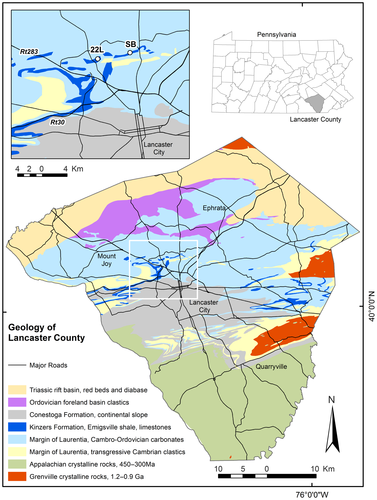
Three facies of the Emigsville shale, broadly distributed along a north-west–south-east onshore–offshore gradient of carbonate/clastic accumulation and inferred depth of the seafloor, were differentiated by Skinner (2005) into: (1) impure carbonate; (2) massive pelitic; and (3) fine pelitic facies. The first consists primarily of relatively thickly bedded calcareous pelite and siltstone, with abundant skeletal allochems (commonly leached) and burrows recording extensive bioturbation. The latter two facies are differentiated by greater bed thickness and more silt in facies (2), compared with the predominance of fine lamination, limited bioturbation, and common occurrence of diagenetic euhedral pyrite in facies (3). The former presence of pyrite, now oxidized as goethite or entirely leached away, is commonly represented by cubic voids, typically 60–200 μm on a side (Fig. 2A, B). This implies preservation of organic matter and reducing conditions within the sediment, but not necessarily on the surface of the sea floor. Rhythmically bedded sediments of facies (3) were further differentiated by Skinner (2005) as fine and shelly tempestite taphofacies, set apart from occasional mat-grounds.
Deposition of the Kinzers Formation as a whole has been characterized as basinal (Gohn 1976). However, neither the fine clastic sediments interpreted as tempestites by (Skinner 2005), nor the diverse shelly faunas preserved at some localities, suggest that the basal Emigsville shale was deposited off the continental shelf.
Kinzers Lagerstätten, where lightly sclerotized and soft parts are preserved, occur in the pelitic facies (2) and (3). No one factor facilitating special preservation has left a definitive signature on these facies. Authigenic pyrite, fine-scale graded beds, and trilobites preserved in full articulation at some horizons implicate anoxia, burial by sudden influxes of sediment, or possibly local, ephemeral excursions of salinity (Skinner 2005) or magnesium-enriched brine (Johnston et al. 2009; Powell 2009). However, the recurrence of distinctive associations of bottom-dwelling organisms in Emigsville faunas and the lack of evidence of long-distance transport reflect an environment that was not generally inhospitable to life on the sea floor.
Pelagiella, including the new material described in this paper, most commonly occurs in the Fine Pelitic facies of the Emigsville shale (Skinner 2005), in association with brachiopods and hyoliths, but not together with algae or taxa dependent on special preservation.
Modern systematic work, notably that of Lieberman (1999), Vannier et al. (2007) and Pates & Daley (2019), has enhanced our knowledge of the Emigsville fauna. Nonetheless, the age of the Kinzers Formation is still not well constrained, being determined by its fauna to lie within the classic Olenellus–Bonnia Zone (Brezinski et al. 2013). Since strata well above and below the Emigsville Member also yield Olenellus, it may be inferred that the age of the Emigsville fauna is late Dyeran (Cambrian Series 2, Stage 4, c. 512 Ma; Holmes et al. 2018). Hence the age of this fauna lies between those of strata yielding the Chenjiang fauna in China (Series 2, Stage 3, Qiongzhusian c. 518 Ma; Zhao et al. 2015) and the Burgess Shale in Canada (Series 3, Drumian, c. 505 Ma; Holmes et al. 2018). The Emigsville shale shares both its preservation of soft-bodied fossils and many characteristic taxa with these better known biotas (Gaines 2014; Holmes et al. 2018).
Material, provenance, methods and archiving of specimens
Specimens of shale and very fine siltstone bearing Pelagiella exigua Resser & Howell, 1938 with associated impressions of paired clusters of chaetae were obtained from a temporary excavation in the Emigsville Member of the Kinzers Formation, at the intersection of Settlers Bend and Buch Avenue (Fig. 3; 40.09495°N, 76.3217967°W), in Manheim Township, 6 km north of Lancaster, Pennsylvania. Over 100 recognizable shells of P. exigua occur on a single 10 × 8 cm part-and-counterpart slab (USNM 617253p, 617253cp; Fig. 4). A smaller piece of shale (USNM 617254p, cp, part and counterpart) preserves a coquina of shells, now external and internal moulds (Fig. 5). The shells have been studied by light microscopy, without special preparation. Photographs of the slab and counterpart were taken with a Nikon D750 and of the coquina with a Leica M 80 HD microscope and camera at Franklin & Marshall College. High-resolution photographs of individual shells and their chaetae were taken using a Leica MZ16 microscope at Yale University. SEM images of chaetae aligned in the form of a three-dimensional cluster were acquired by a Philips XL 30 environmental scanning electron microscope (ESEM), also at Yale University. The specimens have been deposited, with permission of the owners of the property from which they came, in the collection of the Department of Paleobiology at the US National Museum of Natural History, in Washington DC.
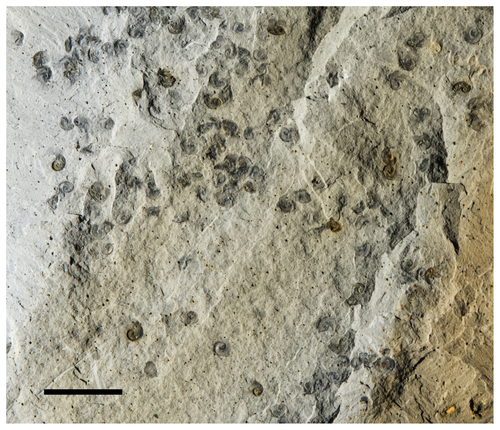
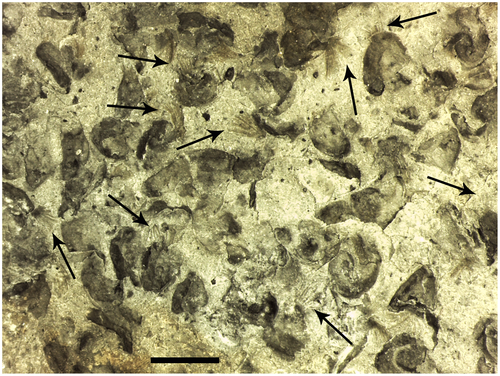
Institutional abbreviations
NMNS, North Museum of Nature and Science, Lancaster, Pennsylvania, USA; NMVP, Museum of Victoria, Melbourne, Australia; PMU, Museum of Evolution, Uppsala University, Sweden; SAMP, South Australian Museum, Adelaide, Australia; USNM, US National Museum of Natural History (Smithsonian Institution), USA.
Preservation and taphonomy
The newly described specimens of Pelagiella exigua occur in two distinct associations. In one case, more than 100 shells are scattered across a single bedding plane, on part and counterpart surfaces of a 10 × 8 cm slab of shale (USNM 617253p, cp; Fig. 4). The shells are similar in size, a little more or less than 2 mm in diameter. The shells were compacted during early diagenesis and subsequently dissolved. Their preservation varies from partial internal moulds with some three-dimensional relief to flattened composite moulds. These represent two to four originally separated inner and outer surfaces, in a plane where all preserved features are superimposed (Figs 2A, B; 6). Some are no more than flattened ‘ghosts’ representing little more than outline shapes of the shells (Figs 2A, 4).
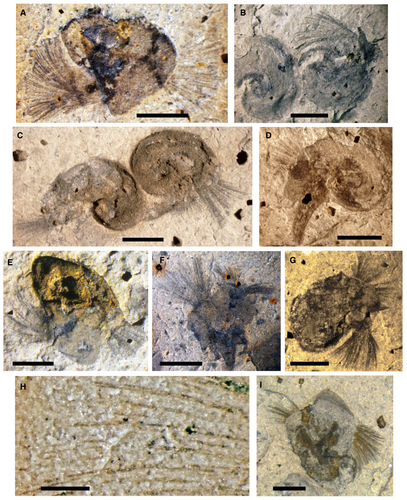
Skinner (2005) likewise observed partial steinkerns inside shells of Pelagiella from the Emigsville Member of the Kinzers Formation. Using energy dispersive spectroscopy (EDS), he showed them to consist largely of pyrite (since oxidized to goethite), phosphate and aluminosilicates. He inferred this mineralization to represent partial replacement of soft tissues, mediated by microbial action. Differences in preservation among our specimens, in close proximity to one another, are here inferred to record variation in the extent to which decaying tissue promoted early mineralization within the shells.
The shells occur in a variety of orientations. On the counterpart surface, 11 of them have apertures clearly facing to the right; in 20 cases they spiral to the left. Many shells show by their roughly triangular cross-sections (Fig. 6A) that they were embedded at an angle in very soft sediment. Most of the animals were lying on their sides (Fig. 6B, C, D). These observations imply that the organisms were buried suddenly and not in a consistent in life orientation.
More than a third of the shells on the slab are accompanied by impressions of one or two clusters of fine, straight or gently curved bristles (Figs 2B, 6). These extend 0.5–0.8 mm outward from what are inferred to have been the anterior left lateral and the right anterior margins of the shell (Figs 2B, 6A, D, G, I; for discussion of our revised orientation of Pelagiella, see below). The bristles in some clusters are tightly apposed (Fig. 6D), but in most cases they splay as broad fans (Figs 2A, 6), flattened in two dimensions. From their clustered associations, their dimensions, and the modest flexibility indicated by their variable curvature (conjunct within a cluster), we infer these bristles to have been chaetae.
Preservation of these impressions, some of which are stained by iron oxides, may have been enabled by inhibition of bacterial decomposition by clay (McMahon et al. 2016), or by rapid preservation of silica-cement, if the high silica saturation state of the Ediacaran ocean (Tarhan et al. 2016) persisted through the early Cambrian. Subsequently, the chaetae may have been filled or replaced by pyrite framboids during diagenesis, like those of polychaete annelids in the Burgess Shale (Smith 2014).
The smaller piece of shale (USNM 617254p, cp), represents a different association. It displays a dense aggregate of moulds of shells, swept together at all angles and less flattened (Fig. 5). Many of these shells are also accompanied by impressions of chaetae. Two of these clusters of chaetae are preserved in three-dimensions, showing their arcuate proximal attachment around a semicircular node at the base (Figs 2C, 7).
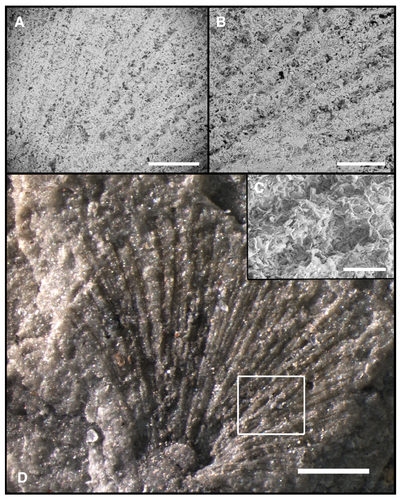
The preservation of monospecific assemblages of similarly sized shells of Pelagiella exigua, many with associated impressions of chaetae, implies that the organisms were alive or very recently dead when they were buried. These animals may have been swept up from the surface of algal/bacterial mats (Pojeta & Runnegar 1976), they may have fallen from life on the surfaces of algal fronds (Parkhaev 2008), or if they were pelagic (Dzik & Mazurek 2013) they could simply have sunk through the water column in conjunction with the event that killed them. This last alternative is unlikely, given both the size and shell thickness of these organisms and the global absence of Pelagiella from pelagic faunas in deep ocean sedimentary rocks.
Faced with adverse conditions, animals with protective shells generally withdraw into them. Some environmental insults cause organs to contract violently and become contorted. However, these organisms appear have been induced to relax following their demise, causing their chaetae to be extended to varying degrees postmortem. Asphyxia resulting from hypoxia (Yoann et al. 2019) or high concentrations of Mg++ ions (Acosta-Salmón & Davis 2007) can bring about this kind of relaxation, so either of these factors (see above) could have been involved here.
Form, disposition and potential operations of the chaetae
The impressions of bristles emerging in clusters from the apertures of shells of Pelagiella exigua, interpreted here as chaetae, rarely cross and they do not branch (Figs 2B, 6A–I, 7). The chaetae are 5–10 μm wide and up to 1.3 mm long (Fig. 2C; obscured proximally within most compressed shells). As many as 50 chaetae occur in each cluster. The clusters emerge in various directions, depending partly on the orientation of shells relative to their flattening in the shale. Generally, the cluster on the apical side of the shell (anatomical right in our new reconstruction, see below) emerges perpendicular to the inferred margin of the aperture, whereas that on the umbilical side (anatomical left) radiates obliquely from its anterior midsection (Figs 2B, 6D, G).
For example (Fig. 2B), chaetae aligned perpendicular to the periphery of the whorl project from underneath the laterally compressed shell, whereas chaetae on the left-hand side of the animal appear where they emerged, preserved in the plane of compression. The orientation of chaetae on the umbilical side of this individual, parallel to the surface of the shell, is inferred to be a result of rotation during compaction. In some specimens (Fig. 6C, D), the clusters of chaetae are more or less tightly apposed, showing that they were extensible and could be retracted, although possibly not all the way back into the shell.
If P. exigua were benthic and lived with its tangential aperture parallel to the substrate, like modern gastropods with capacious apertures, the chaetae must have projected outward rather than downward from the visceral mass or foot. In flattened specimens with the best organized arrays, the chaetae of each cluster appear to converge toward points well within the interior of the body whorl. Numerous specimens with two discrete clusters of chaetae still in place suggest singular sites of attachment, on either side of the body (Figs 2C, 6). A few in situ clusters are somewhat disordered, with chaetae misaligned and crossing one another (Fig. 6F). These are thought to reflect post-mortem disaggregation.
A remarkably preserved, isolated three-dimensional array of chaetae documents the proximal configuration of the clusters (Figs 2C, 7), otherwise hidden within the compressed shells. The chaetae converge on a basal node, potentially a mould replacing the muscle mass by which they were articulated. The funnel-shape of this disjunct cluster and its basal node imply that in life the chaetae were extended as shallow hemiconical arrays, rather than as planar fans.
The states of preservation of the chaetae show them to have been stiff but slightly flexible in life (Figs 2B, 6). The consistent form, disposition and orientations of the clusters of chaetae with respect to the shells indicate that they were features of the shell maker, not those of an adventitious occupant of dead shells. These structures were comparable in form and inferred stiffness/flexibility with chitinous chaetae of living brachiopods (Lüter 2000) and many polychaete annelids (Hausen 2005).
Given these comparisons, the chaetae of Pelagiella exigua might be expected to have been deployed along the mantle margin, as in adult brachiopods, or anchored in follicles of parapodia-like appendages, as in polychaetes. Insertion along the mantle margin is ruled out by the configuration of the chaetae as clusters that converge toward points of attachment well inside the shell. Furthermore, significant masses of protractor and retractor muscles would have been required, as in polychaete parapodia, to operate numerous chaetae as components of an array that was large in size relative to that of the animal.
The clusters of chaetae might have been deployed by parapodia-like appendages analogous to the epipodial tentacles of vetigastropods (Haszprunar et al. 2017). More probably, given their inferred points of convergence, they were attached further back on the left and right sides of the foot. Protraction of the foot might have allowed the arrays to protrude a considerable distance beyond the shell. Retraction could have withdrawn them well into the mantle cavity, forming a fringe of chaetae extending around much of the shell's aperture. On the other hand, the asymmetric alignment of the chaetal appendages relative to the anterior–posterior axis of the animal (Figs 2B, 6A, D, E, G) suggests that they could have been independently protruded and retracted.
Taken together, these observations and inferences lead to the conclusion that Pelagiella exigua was equipped with a pair of anterior–lateral, muscular, parapodia-like appendages, arising from the body wall or the foot, each bearing a cluster of chaetae that could be extended as a hemiconical array and to some degree retracted.
PhyLogenetic and functional implications of the chaetae
Chitinous chaetae, canonical features of annelids and brachiopods, are not known as such in other living lophotrochozoans. However, mopaliid chitons, juvenile octopods and bryozoans employ chitinous materials with ultrastructural similarities to those of chaetae (Fig. 8, CMTs; Brocco et al. 1974; Gordon 1975; Leise & Cloney 1982; Giribet 2008) and chitin is an essential component of the organic matrix of mollusc and brachiopod shells (Zhao et al. 2018). Well-preserved fossil chaetae are known from Cambrian polychaete annelids (Conway Morris 1979; Eibye-Jacobsen 2004) and brachiopods (Topper et al. 2015). Among small carbonaceous fossils from the late Cambrian of Baltica, Slater et al. (2017) recognized isolated strap-shaped chaetae, with bifid and serrated tips, like brush chaetae of modern annelids. The chaetae of P. exigua are similar in size to these fossils, but dissimilar in form, comparable to the ‘indeterminate spinose elements’ reported in the same assemblages.
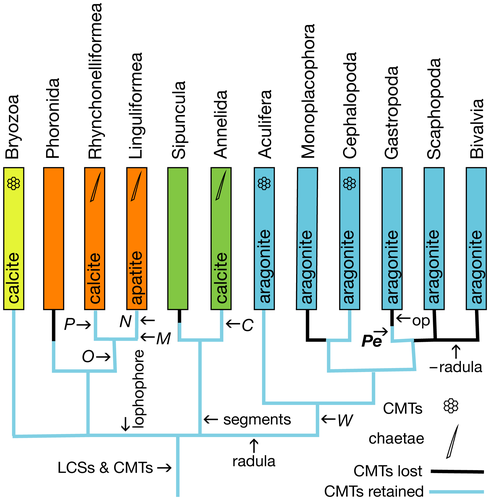
The capacity to synthesize chitin predates the common ancestor of animals and fungi, and chitin synthases belonging to a monophyletic gene family (Fig. 8, LCSs) are widely distributed among the lophotrochozoan phyla. The genome of the limpet Lottia gigantea (Gray in Sowerby, 1834) codes for nine chitin synthases belonging to four paralogous groups that also occur in annelids (Zakrzewski et al. 2014). Bivalves, a chiton and a brachiopod are also known to express some members of these groups. Most of these chitinases have a common N-terminal myosin motor domain that interacts with the actin cytoskeleton to deliver the enzyme to sites of secretion. In both annelids and brachiopods, synthesis occurs in chaetoblasts of the chaetal follicles, development being controlled by the expression of particular Hox and homeodomain genes (Zakrzewski 2011; Schiemann et al. 2017). Thus, the genetic underpinnings required for chitin synthesis and chaetal construction were present in the common ancestor of annelids, brachiopods and molluscs.
Up to now, only two of these phyla have been known to express the capacity to construct chaetae as such. In the Mollusca, this capacity would appear also to have been retained if the uncalcified dermal sclerites of the putative stem group mollusc Wiwaxia are indeed homologous with chaetae (Butterfield 1990, 2003; Vinther & Nielsen 2005; Smith 2014; but see Chen et al. 2015) and if the calcareous sclerites of the aculiferans are also homologous with chaetae (Scheltema 1993; Smith 2014). Among the conchiferans, the corresponding genes may be employed mainly in producing chitin for the organic matrix of calcareous shells and gastropod opercula (Poulicek 1983; Weiss et al. 2013). These inferences are all contested. The issue turns on whether structures composed of chitin that have evolved in different anatomical settings are regarded as being homologous, or as being independent, convergent applications of the same molecular and tissue-building toolkit. In fact, processes that are homologous at one level of pattern formation may be expressed independently at different levels or sites of anatomical deployment. Here, this issue does not arise, as we present direct evidence of the occurrence of chaetae as such in the stem group gastropod Pelagiella.
Chaetae may have sensory, locomotory, feeding or protective functions (Rouse & Pleijel 2001; Merz & Woodin 2006; Topper et al. 2015). Pelagiella exigua had two sets of chaetae, long, slender and apparently flexible, like capillary chaetae of annelids (Merz & Woodin 2006), but stiff enough to have been articulated as cohesive parts of the appendages to which they were attached. Chaetae employed by annelids in swimming, often jointed and with lateral flanges, are typically deployed along the length of the body. The two arcuate chaetal arrays of P. exigua appear neither to be appropriate in form nor were they anatomically well deployed to serve this purpose.
Given the widely gaping, angular aperture of its shell, it is unlikely that Pelagiella had an operculum. Consequently, P. exigua might have benefited from a protective screen, excluding interlopers and coarse sediment, as in some brachiopods (Rudwick 1970). But the form, flexibility and occurrence in clusters of the chaetae (Figs 2B, 6) indicates an active function, not the passive role of a rigid fence or grating. Tactile sensation, observed as a function of chitinous hairs of living chitons (e.g. Mopalia muscosa (Gould, 1846)), has been inferred for the radial arrays of exceptionally long chaetae of the Cambrian brachiopod Micromitra burgessensis Resser, 1938 (Topper et al. 2015). This purpose seems less likely to have been well served by the two integrated clusters of chaetae wielded by P. exigua than it would have been by more broadly distributed exploratory sensors.
Hence, in part by exclusion, but directly on account of the fact that the chaetal arrays appear to have faced outward and forward, it seems most likely that P. exigua employed its chaetal appendages primarily in food gathering. If these snails lived on the surface of the sea floor or in large numbers on seaweed, both consistent with their palaeoecology and modes of preservation (Parkhaev 2008), they may have deployed their chaetae like the cephalic cages of flabelligerid annelids to trap and harvest small organisms and flocculent or floating detritus (Jumars et al. 2015, appendix A). The extended chaetal arrays of P. exigua are remarkably similar in form to arrays of hairs borne by the second maxillae of present-day calanoid copepods studied experimentally by Koehl (1995). Although larger (×5, linear dimensions), the chaetal arrays of P. exigua could likewise have operated as leaky sieves, at Reynolds numbers greater than 1, in ‘fling and squeeze’ trapping of food particles. For explanation of these evocative terms and the process they invoke, see Koehl (1995). Alternatively, in environments featuring high concentrations of dissolved nutrients (Ridgwell & Arndt 2014) and intermittent deprivation of oxygen, the large surfaces of the chaetal arrays might even have been employed in bacterial farming, like that increasingly recognized in the deep ocean today. Finally, if P. exigua were mobile on the seafloor, its chaetal arrays could have served as whisk-brooms, stirring up detritus and meiofaunal organisms to be sorted by epipodial or cephalic tentacles before being passed to the mouth. This mode of feeding is common among annelids, and not dissimilar to that of gastropods adapted to suspension or selective deposit feeding (Lopez & Levinton 1987; Jumars et al. 2015, appendix A).
Systematic relationships of Pelagiella: alternative hypotheses
There has never been any real doubt that Pelagiella was a mollusc. But disagreement persists over whether it was a helcionelloid expressing partial torsion, hence a stem group gastropod (Runnegar 1981), a divergent, untorted paragastropod (Linsley & Kier 1984), an untorted, endogastric relative of helcionelloids (Peel 1991), or a fully torted stem, or even crown group, gastropod (Parkhaev 2001a, 2007a; Landing et al. 2002). Resolution of this issue depends on indirect evidence of the disposition of soft parts of the animal that are not preserved and their orientation in relation to its shell.
Initially, real but misleading points of comparison led Matthew (1895b) to interpret the type species on which he defined Pelagiella as a swimming heteropod. The shell of P. atlantoides has a widely gaping aperture that is unusually thickened (‘gerontically’) around part of its margin. From these features of derived and geologically much younger pelagic gastropods, Pelagiella gained its inappropriate name.
In an influential paper, Knight (1952) sought to locate the origin of torsion among Cambrian helcionelloids. Acknowledging limited evidence, he reconstructed the anatomy of Coreospira and Oelandia as fully torted gastropods. But he remained uncertain to the end that Pelagiella was a gastropod (Knight et al. 1960), citing in particular the unusual shape and thickened margin of its aperture. In his view (Knight 1952, fig. 1), ‘Pelagiella and its allies’ constituted a distinct, untorted lineage established just prior to the emergence of the Gastropoda.
Runnegar & Pojeta (1974; Pojeta & Runnegar 1976) rejected this analysis, interpreting all bilaterally symmetrical helcionelloids as untorted monoplacophorans. They supposed, citing consistent dextral coiling of their helical shells, that Aldanella and Pelagiella were among the earliest known gastropods. Later, Runnegar (1981) recognized left and right muscle scars, offset by about 10° along the anterior–posterior axis of a remarkably well preserved steinkern of Pelagiella atlantoides (Fig. 9). From associated ridges interpreted as traces of mantle attachment to the shell, he inferred that space occupied by the mantle cavity was incompatible with 180° of torsion. Hence, he treated Pelagiella as a helcionelloid that was slightly torted (Fig. 10A).
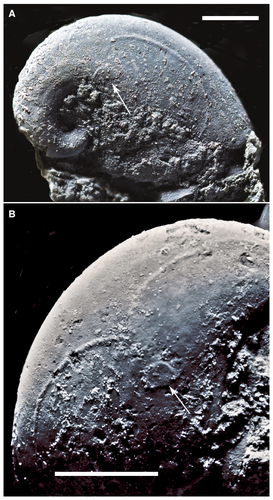
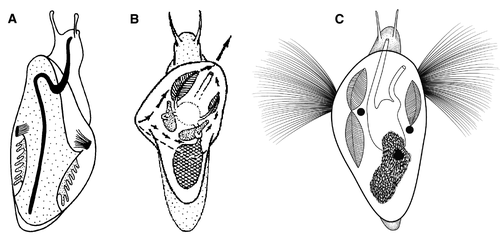
Meanwhile, Linsley (1977) had argued that the shape of the aperture of Pelagiella, elongated perpendicular to the coiling axis of its shell (Fig. 1), is uncharacteristic of gastropods. To Linsley & Kier (1984), this implied a body plan calling for assignment of the pelagiellids to an extinct class of early untorted molluscs, which they established as the Paragastropoda. Peel (1991) also doubted that Pelagiella was a gastropod, despite supposing that its shell coiling was endogastric. He assigned it, with Aldanella, to an early branch off the conchiferan stem, close to the Helcionelloida.
A cladistic analysis of early Palaeozoic gastropods by Wagner (2002), based entirely on external shell characters (i.e. without reference to infrequently preserved muscle attachment scars), endorsed the suspicion expressed by Linsley & Kier (1984) that the taxon Paragastropoda is not monophyletic. In this analysis, pelagiellids appeared as the sister group of onychochiloid gastropods, with which they were erroneously supposed by Dzik (1994) to share similar protoconchs. These taxa were next most closely linked, as also by Pojeta & Runnegar (1976) and by Peel (1991), to the helcionelloids. Wagner (2002) considered all these taxa to have been untorted, conventionally assuming the origin of torsion to have coincided with the emergence of an apertural sinus or slit required to accommodate the sanitary requirements of a post-torsional mantle cavity.
In contrast, building on mainly stratigraphical studies of Rozanov & Missarzhevsky (1966), Russian scholars now assign Pelagiella and all other helcionelloids to the gastropod subclass Archaeobranchia (Parkhaev 2000, 2001a, 2017). They suppose that all these early molluscs, most of them bilaterally symmetrical and some with uniquely specialized shell forms (e.g. Latouchella, Yochelcionella) underwent full developmental torsion. This view is based largely on presumed endogastric coiling, the disposition of retractor muscle scars inferred from microstructural fabrics observed in some taxa, and an anterior mantle cavity based on reconstructions of the circulation of respiratory currents (Fig. 10B; Golikov & Starobogatov 1975; Parkhaev 2000, 2008).
The pelagielloids Aldanella and Pelagiella were not hyoliths
Dzik & Mazurek (2013) argued that Aldanella and other pelagielloids should tentatively be assigned to the Hyolitha. They cited the supposed sharing of a ‘mucro’ by specimens of Aldanella attleborensis Shaler & Foerste, 1888 from Siberia, a few steinkerns of Pelagiella, and larval shells of certain hyoliths (Dzik 1978). Except in chitons, where a mucro represents the node that was calcified as a whole, prior to the onset of marginal accretion of a shell plate, this feature is variably expressed and rarely recognized. Where it is distinctive, it may represent a discrete stage of larval shell development as Dzik (1994) suggested, but no other author has reported a mucro in a pelagielloid.
Dzik & Mazurek (2013) also argued that the shell microstructure of pelagielloids, lacking nacre, is uncharacteristic of early molluscs and comparable to that of hyoliths. However, Kouchinsky (2000), Vendrasco et al. (2010) and Moore & Porter (2018) recognized two laminae, originally composed of aragonite needles oriented in perpendicular directions, that constitute a plesiomorphic grade of evolutionary advance in skeleton formation common to the earliest conchiferan molluscs and hyoliths. Furthermore, Runnegar (1990) reported a laminated microstructure, now thought originally to have been nacreous, in a South Australian species of Pelagiella.
Dzik & Mazurek (2013) also illustrated a single specimen of A. attleborensis inside which three or four short phosphatized rods are preserved at high angles to one another. Citing our conference abstracts reporting chaetae of Pelagiella (Thomas et al. 2010a, b), they interpreted these rods as fragments of chaetae. The rods are of about the right diameter, but they cannot be distinguished with certainty from tubular algal filaments commonly assigned to Girvanella (C. B. de Wet, pers. comm.) Moreover, it is hard to see how flexible chitinous chaetae might have been transformed to short, brittle fragments prior to lithification. Aldanella might have had chaeta-bearing appendages like those of Pelagiella, but this evidence is at best inconclusive. Chaetae have not, in any case, been reported as features of hyoliths.
The arguments advanced by Dzik & Mazurek (2013) were intended to exclude pelagielloids from the Mollusca. But they overlooked or dismissed evidence of helical shells, muscle scars, shell microstructure and external sculpture that is consistent with reconstruction of Pelagiella as a stem group gastropod. Pelagielloids exhibit none of the distinctive characters of hyoliths. With straight, conical shells, guts like those of sipunculid worms (Devaere et al. 2014), and new evidence of an organ interpreted as a suspension-feeding lophophore (Moysiuk et al. 2017), the hyoliths appear to have been lophophorates. We see no reason to reject the well established view that Pelagiella is an early conchiferan mollusc.
Soft-part anatomy of Pelagiella
More is known about the soft-parts of Pelagiella than most fossil gastropods without living counterparts (Runnegar 1981; Bischoff 1990; Parkhaev 2001a). Our discovery of two sets of chitinous chaetae adds to this body of evidence, which may be used to test previous reconstructions of its anatomy (Fig. 10A, B) and to prompt consideration of a new one (Fig. 10C).
Muscle scars and their implications
Patches of polygonal impressions and other features interpreted as muscle scars have been reported from phosphatic internal moulds of several species of Pelagiella. Some of these reports may represent evidence of muscle attachment, but they are all equivocal. Landing et al. (2002) figured an internal mould, designated as Pelagiella sp. from Morocco, bearing a kidney-shaped feature on its umbilical surface. They interpreted this as the attachment scar for a large columellar retractor muscle, comparable to that of the abalone, Haliotis. However, this feature lacks evidence of a muscle track, scalloped edges, or imprints of myostracal prisms that would confirm it to be a muscle attachment scar.
Isakar & Peel (2007) likewise inferred the occurrence of a columellar muscle in Aldanella. They reported a spiral groove on the apical surface and a weakly defined spiral ridge on the umbilical surface of a steinkern of Aldanella kunda Opik, 1926 from Cambrian Series 1 strata in Estonia. These features appear to be comparable to a pair of deeply pitted circum-umbilical grooves on the apical and umbilical margins of steinkerns of two species of Pelagiella, interpreted by MacKinnon (1985; see also Runnegar & Jell 1976, fig. 7D, F) as impressions of narrow ridges serving as sites of muscle attachment. These features are better placed, adjacent to the axis of the shell, to be interpreted as traces of attachment for columellar muscles than that figured by Landing et al. (2002).
Evidence of a single pair of retractor muscles preserved on a topotype steinkern of P. atlantoides (Fig. 9) is less ambiguous. The two scars have the elevation and sharp edges of muscle scars observed on internal moulds of fossil bivalves where their interpretation is unequivocal. Associated with these scars on both sides of the steinkern are fine, gracefully curved ridges, reflecting grooves on the interior surface of the shell. In each case these turn inward toward the muscle scars (Fig. 9), as would be expected if they represent lines of attachment of the mantle to the shell, at its junction with the visceral mass (Runnegar 1981). Since pedal retractor muscles extend into the foot from the visceral mass, the dorsal margin of the mantle cavity was limited ventrally by their presence, and its floor curved down to encompass them. In addition, these arcuate grooves may record the presence of left and right ctenidia, each having their efferent membranes attached ventrally to the mantle at its junction with the viscera, as in living vetigastropods such as Pleurotomaria and Scissurella (Yonge 1947). If so, this implies that development of the ctenidium on the apical (right) side of the animal was reduced relative to that on the umbilical (left) side.
These observations suggest that Pelagiella had an extensible foot, differentiated from the visceral mass as in most multispiral crown group gastropods. This feature may already have been present, prior to both torsion and spiral coiling of the shell, among the helcionelloids. Whether or not in Pelagiella the foot terminated anteriorly in a well-developed head, with cephalic tentacles and other sensory organs such as those especially characteristic of vetigastropods (Haszprunar et al. 2017), is so far unknown.
Unique preservation of digestive gland
Two remarkable specimens of Costipelagiella sp. have parts of a phosphatized digestive gland preserved within the last whorl of the shell (Bischoff 1990). In most living gastropods, the left lobe of the digestive gland is generally larger than that on the right (Fretter & Graham 1962). However, among living vetigastropods such as Haliotis (Wood & Buxton 1996) and the scissurellids (Montouchet 1972), the digestive gland occurs on the right-hand side of the animal. The disposition of the digestive gland observed in Bischoff's specimens is thus consistent with space made available by reduction in size of the right ctenidium in these taxa and our reoriented reconstruction of the anatomy of Pelagiella (Fig. 10C). However, in his figures and reconstruction (Bischoff 1990), the gland appears to occupy much of the last whorl of the shell, more space than would be expected even if it constitutes both the midgut and foregut portions of the gland.
Untorted or torted during development? What do the chaetae tell us?
The paired clusters of chaetae of Pelagiella exigua need to have been deployed anterolaterally, not posteriorly, to have functioned effectively in any likely role. Hence, the disposition of the chaetal appendages establishes the animal's anterior–posterior polarity in relation to its shell (Fig. 10C). This inference implies that Pelagiella's shell coiling was endogastric (Fig. 11), as in gastropods.
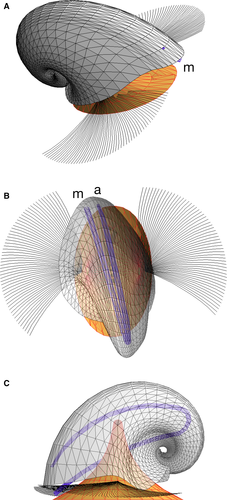
Runnegar (1981) thought that the mantle cavity of P. atlantoides (Figs 9, 10C) extended along the whole length of the foot, as in chitons and monoplacophorans, rather than being confined to the anterior region of the body as in gastropods. Furthermore, he took asymmetric dextral coiling and its anatomical consequences to indicate that Pelagiella was an exogastric helcionelloid, exhibiting about 10° of partial torsion. So, he reconstructed it as a transitional form with a limited developmental twist: counterclockwise as in gastropod torsion, a mantle cavity extending along the entire right-hand side (his orientation) of the body, and paired posterior ctenidia (Fig. 10A). He suggested that the helically coiled shell evolved to lower the animal's centre of gravity and that partial torsion was required to balance the shell at an angle over the body axis, in accord with Linsley's (1977) ‘third law’ of gastropod shell form. However, the adaptive function invoked to have required partial torsion cannot be sustained, as the stabilizing role of gravitational force is insignificant at the scale of a 2 mm organism living in seawater. Linsley (1977) specified that his ‘laws’ applied only to marine prosobranchs greater than 10 mm in length, noting the role of surface tension at smaller scales. Likewise, forces exerted by muscles (Lai et al. 2010) and adhesion or friction retarding locomotion over a layer of mucus (Denny 1980) are large relative to that of gravity at this scale.
In his reconstruction of Pelagiella as an archaeobranchian gastropod (Fig. 10B), Parkhaev (2001a, 2008) assumed the animal to have undergone full torsion in its development. This reconstruction is based primarily on supposed directions of flow of respiratory currents through the anterior mantle cavity, a single inhalant current entering the mantle cavity in the region of the auricle observed in some species on the umbilical side of the shell (Fig. 1B). The right ctenidium is shown reduced in size relative to that on the left. A large mass of gonad is associated with the small digestive gland shown on the right side, but not on the left. The latter features of Parkhaev's reconstruction are not based on observational evidence of fossils; they were inferred explicitly from the anatomies of living gastropods (Parkhaev 2001a). Here, and elsewhere in his accounts of Pelagiella and the helcionelloids as archaeobranchians, Parkhaev (2000, 2001a, 2008, 2017) has to a large extent conceived them anatomically as they ought to have been if they were in fact gastropods.
Our inference that the chaeta-bearing appendages of Pelagiella were necessarily anteroventral leads to a reconstruction such that the shell was endogastric, with its rapidly expanding aperture growing forward away from its apex (Fig. 10C). Asymmetry of the gills is based on the curved grooves on the interior of the shell of P. atlantoides (see above). This asymmetry is inferred to have arisen from the combined effects of torsion and reallocation of space in the mantle cavity due to dextral coiling of the shell (Yonge 1947; Page 2006). It is consistent with the hypothesis that Pelagiella was a gastropod, with an extended left gill comparable to those of Littorina and the trochid Monodonta (Fretter & Graham 1962), and a reduced right gill as in many living vetigastropods.
Our reconstruction of Pelagiella as a gastropod that underwent torsion, leading to asymmetric development of its ctenidia, is consistent in these respects with that of Parkhaev (2001a, 2008). However, we regard the curvilinear grooves tracing attachment of the gills as evidence that he lacked. In our reconstruction, the main inhalent respiratory current is thought to have entered the mantle cavity along the left-lateral margin of the aperture, at a sinus (even a prominent auricle in some species, Fig. 1B) that gives the aperture of Pelagiella its unusual shape. This current passed either through the cluster of chaetae or adjacent to the auricle, where a sinus has sometimes been recognized. Likewise, another respiratory current is inferred to have entered the mantle cavity through or adjacent to the cluster of chaetae on the right. Circulation of these respiratory currents passed up through the gills and forward, above and between them on both sides of the viscera, passing the anus to exit right of the head, as Parkhaev (2001a, 2008) suggested (Fig. 10B).
The evidence now available (shell and body orientation, chaetae and the disposition of soft parts) constitutes the basis for our interpretation of Pelagiella as a gastropod, with a dextrally coiled, anteriorly expanding shell, that underwent full torsion during its development (Fig. 10C). This is consistent with prior proposals that Aldanella (Pojeta & Runnegar 1976), which appeared stratigraphically earlier, and the pelagiellids (Golubev 1976; Parkhaev 2001a, 2008) may have been torted gastropods. However, this argument does not apply to helcionelloids in general. These lack evidence of derived characters associated with torsion. We interpret the helcionelloids as paraphyletic stem group conchiferans (Fig. 12), not crown group gastropods as Parkhaev (2001a, 2007a, 2008) implied by assigning them all to the gastropod class Archaeobranchia.

Discussion
Newly elucidated, Pelagiella remains an enigma. On the one hand, we infer that it expresses torsion, the canonical derived character of crown group gastropods. On the other, it bears chaetae, a plesiomorphic lophotrochozoan character linking molluscs to their common ancestry with annelids and brachiopods (Fig. 8). Our evidence from the fossil record provides an affirmative test of this hypothesis, which until now has been based on phylogenetic analyses of molecular and morphological data drawn from living organisms (Peterson & Eernisse 2001; Giribet 2008). Moreover, it extends its embrace to include the gastropods, amongst which chaetae have not so far been recognized in any living or extinct taxon.
If the occurrence of chaetae in Pelagiella represents retention of a plesiomorphic character, transmitted by direct descent from an ancestral homologue, chaetae must have been retained by at least some helcionelloids (Fig. 12). A gradational series of shell forms can be recognized from helcionelloids such as Latouchella, through Archaeospira, to Pelagiella. Hence chaetae could have been passed directly on to Pelagiella and perhaps even to the sedentary Ordovician macluritaceans, whose means of feeding are as yet unknown. But we have at present no evidence of intermediary chaeta-bearing helcionelloids or taxa linking the pelagielloids to any later descendants.
If chaetae are plesiomorphic for lophotrochozoans (Dunn et al. 2008; Giribet, 2008; Zakrzewski 2011), this implies the retention of chaetae in at least the line leading ultimately to the Gastropoda and their loss in all other conchiferan clades, as well as in lineages leading to the Sipuncula and Phoronida. Alternatively, chaetae may have re-emerged in the Pelagiellida, having been lost in the stem of Conchifera (Fig. 12). Living cephalopods generally lack chaetae. But in juvenile octopods, tufts of bristles known as Kölliker's organs are remarkably similar to annelid chaetae, both in form and in their development from basal chaetoblasts with microvillae (Brocco et al. 1974). It has been suggested that Kölliker's organs may be plesiomorphic in origin (Giribet 2008), hence exemplifying atavism (see Hall 1984; Raff 1996, pp. 386–389), although this case has been attributed to convergence by Hausen (2005). The same inferences potentially apply to the re-emergence of chaetae in Pelagiella. In each case, a lost feature with a complex pattern of development reappears in a later clade after supposedly irrevocable loss. Neither hypothesis is evidently more parsimonious than the other. One involves multiple losses of a functionally significant character state; the other calls for reintroduction of a complex pattern. While direct descent can be corroborated by future discovery of intermediary taxa bearing chaetae, neither hypothesis can at this time be falsified. In fact, the difference between genomic atavism, achieved by reactivation of an inherited but suppressed developmental process, and evolutionary convergence achieved by deployment of the same developmental processes in a new context (the deep homology of Shubin et al. 2009) may be moot. They are effectively indistinguishable here.
By far more remarkable than the reappearance of chaetae in larval octopods is the fact that spicules of a present-day larval solenogaster share relatively complex patterns of serial and transverse organization with those of sclerites of Halkieria and Wiwaxia. Scheltema & Ivanov (2002) proposed that these similarities arose from a shared, genetically based process of skeletogenesis, although they did not go so far as to identify the patterns as being homologous. These authors also noted the co-occurrence in a mollusc, the vermiform multiplacophoran Acaenoplax, of features typical of molluscs and annelids, described in detail by Sutton et al. (2004). In the context of these observations, the hypothesis that the chaetae of Pelagiella arose as an atavistic revival of a pattern forming process that was suppressed in other conchiferan lineages does not seem implausible.
In lophotrochozoan taxa where chaetae and comparable features thought to be homologous with them occur (Fig. 8), they develop in different anatomical and functional contexts. It is hard to see the evolution of these chitinous components in distantly related clades as outcomes of classical homology, as records of direct evolutionary continuity of form, in situ. Rather, they presumably represent the repeated emergence of chitinous novelties in different anatomical circumstances, employing homologous patterns of molecular development regulated by co-opted Hox and other genes, as now documented by Schiemann et al. (2017) in brachiopods and annelids. In some cases, as apparently in Pelagiella, annelids and brachiopods, this deep homology involves more complete replication of a common molecular ‘toolkit’ than others.
Torsion and the time and pattern of emergence of the Gastropoda
If Pelagiella underwent torsion in its development, the emergence in the early Cambrian of this most fundamental of gastropod characters supports the hypothesis that some of the earliest molluscs were already gastropods, as has been inferred from the shapes of their shells (Pojeta & Runnegar 1976). The widely accepted notion that torsion and specialized modifications of the shell's aperture which serve to improve adult sanitation evolved simultaneously during the latest Cambrian rests on the assumption that the latter adaptations were essential to accommodate torsion. Rather, it is more likely that torsion was acquired first, as a key adaptation that enabled a stem gastropod to inhabit a tightly coiled spiral shell. We suggest that the earliest gastropods did not diversify rapidly at first on account of collateral limitations arising from torsion. Later, in association with evolution to larger body sizes in the early Ordovician, gastropods with shells bearing sinuses and slits evolved, resolving these circulatory difficulties. At that time they diversified rapidly, establishing the extant clades and thereby also the gastropod crown group (Wagner 2002).
Whether or not Pelagiella and its near relatives constitute an immediate sister group of crown group gastropods remains to be determined. Given a shell form that Linsley & Kier (1984) found hard to accommodate in the Gastropoda, and now the discovery that it had a pair of chaeta-bearing appendages, Pelagiella is more derived in its character states than Aldanella, especially if the chaetae of Pelagiella were atavistic and unique to its family. Hence, it appears that Aldanella, stratigraphically earlier in its first occurrence and closer to typical gastropods in its shell form, is a more basal member of the clade and probably closer to the root stock from which crown group gastropods ultimately evolved.
Gene regulatory mechanisms characteristic of bilaterians are inferred to have emerged long before they were widely exploited in the divergence of crown group metazoan phyla (Erwin et al. 2011). The evolution of thermoregulatory or behaviourally advantageous feathers among theropod dinosaurs was an early precursor to the later emergence of winged birds, the prior adaptation being repurposed to serve a new function (Prum & Brush 2002). Likewise, among the earliest conchiferans, it now appears that torsion emerged as a key developmental innovation that only considerably later facilitated the evolutionary radiation of crown group gastropods.
Conclusions
The unusual form of the shell of Pelagiella sets it apart from most gastropods. This arises from peripheral expansion of its large and angular aperture, which is often variable in shape. It may be explained by the discovery that this small animal was equipped with two clusters of proportionately large chaetae, comparable in form and stiffness to capillary chaetae of annelids, and up to half or more as long as the shell. These clusters of chaetae could apparently be extended as a pair of broad, forward and laterally directed, hemiconical arrays that were probably employed in feeding, either on bacteria-rich mat-grounds or on the surfaces of algal thalli. Chitinous chaetae are here recognized for the first time as such among conchiferans. This evidence from the fossil record is consistent with genomic data that group molluscs with annelids and brachiopods in the Lophotrochozoa. It also supports the hypothesis that chitinous chaetae constitute a deep homology of this clade.
The disposition of its chaeta-bearing appendages prompts a new reconstruction of the anatomy of Pelagiella. A long left ctenidium extended far back in the mantle cavity and a much shorter one was present on the right. This anatomical asymmetry, comparable to that of well-known living vetigastropods, implies that Pelagiella underwent torsion during the course of its development. On this basis, we recognize Pelagiella as the earliest confirmed stem gastropod.
Systematic palaeontology
Phylum MOLLUSCA Cuvier, 1797Subphylum CONCHIFERA Gegenbaur, 1878Total group GASTROPODA Cuvier, 1797Order PELAGIELLIDA (or PELAGIELLIFORMES) MacKinnon, 1985Superfamily PELAGIELLOIDEA Knight, 1956 (as Pelagiellacea)
Remarks
The diagnosis of this superfamily by Knight et al. (1960) is obsolete and largely erroneous in light of subsequent discoveries and practice. As originally defined, it included only the family Pelagiellidae. Subsequently, it has become customary to include the Aldanellidae in the same superfamily and order (e.g. Rozanov & Missarzhevsky 1966; Linsley & Kier 1984; Parkhaev & Karlova 2011; Bouchet et al. 2017) based on their shared antiquity, dextrally coiled teloconchs, short uncoiled embryonic shell, and lack of an apertural sinus or slit such as is associated with torsion in archaeogastropods (Wagner 2002).
Whether or not this grouping is appropriate, it is likely that both pelagiellids and aldanellids are stem gastropods (rather than stem members of another extant class) and are therefore crown conchiferans (contra Gubanov & Peel 2000). They lived after the last common ancestor of the Gastropoda and Bivalvia, which must have existed prior to the first appearance of Aldanella attleborensis Shaler & Foerste, 1888 in Stage 2 of the Terranuevian, c. 527 Ma (Betts et al. 2018), and prior to the latest common ancestor of the gastropod crown group as defined by the divergence of archaeogastropods (Patellogastropoda + Vetigastropoda ± Neritomorpha) and apogastropods (Caenogastropoda + Heterobranchia ± Neritomorpha) in the latest Cambrian or earliest Ordovician (Wagner 2002; Frýda 2012; Zapata et al. 2014).
On the basis of evidence presented in this paper, the Pelagielloidea includes at least one family, the Pelagiellidae, in which torsion and a single pair of pedal retractor muscles may already have appeared. Although in this respect the Pelagiellida may represent a crownward plesion of the gastropod stem, the first appearance of the family in the Fortunian (c. 530 Ma) is well separated from the presumed time of origin of the crown group (c. 485 Ma). Other basal crown characters, including an operculum and an apertural sinus or slit, appear to have been acquired during this interval.
Family PELAGIELLIDAE Knight, 1956
Diagnosis
Knight et al. (1960) cited that of the superfamily (see above).
Revised diagnosis
Dextrally coiled univalves having a high rate of whorl expansion and a tangential, oval to more or less triangular aperture, the long axis of which is oblique to the coiling axis. Depending on the shape of the growing edge of the aperture, the shell may be smoothly rounded or it may have flat to concave apical and adapical whorl profiles. Growth increments may be embayed on either side of the aperture, generating shallow sinuses. In some taxa, that on the left-hand side of the animal may be more or less greatly expanded, constituting an auricle (Fig. 1B). There is no slit, sinus or peripheral band (sensu Wagner 2002) of the archaeogastropod type.
External ornament varies from fine to distinct growth lines, through coarse divaricate spiral ribs to angular and steeply pitched comarginal plicae. Some otherwise smooth species have a prominent spiral ridge on the apical surface of the shell (Runnegar 1990, fig. 169H–J), but this varies significantly within populations and through ontogeny. The shells were originally aragonitic and are typically recrystallized to sparry calcite. Their microstructure, where known, consists of a thick inner layer of comarginal fibres oriented in chevron-like patterns and an outer layer of spirally oriented subhorizontal fibres or fibre bundles (Runnegar 1990; Vendrasco et al. 2010). An innermost layer of foliated aragonite has been reported from two species (Runnegar 1990; Li et al. 2017).
A topotype of P. atlantoides, the type species of Pelagiella, has a single pair of pedal muscle insertions on the left and right sides of the presumed mantle cavity. This is demarcated by three arcuate grooves that may represent sites of attachment of the mantle to the visceral mass (Figs 8, 9A; Runnegar 1981) or, alternatively, the lines of insertion of efferent membranes of the gills (Fig. 9C). Phosphatized soft parts found within two shells of Costipelagiella sp. exhibit an imbricate branching pattern consistent with Bischoff's (1990) interpretation that they represent a diverticulated digestive (midgut) gland. Also, as reported here, Pelagiella exigua had two sets of stiff but flexible chitinous chaetae that protruded laterally beneath the left and right anterior eaves of the shell.
Remarks
The disposition of chaetae of Pelagiella exigua suggests that the mantle cavity extended from beneath the spire towards the far end of the aperture on both sides of the body. If the animal underwent torsion in its development, the mantle cavity would have been continuous across the distal midline of the body (Fig. 9C). Alternatively, if the position of the visceral mass was that inferred by Runnegar (1981) from the muscle attachment scars (Fig. 9A), the mantle cavity would have been limited to the lateral flanks of the animal. There is no direct evidence for or against the existence of a post-larval operculum. However, the possibility that the chaetae could not be withdrawn entirely within the shell makes it unlikely that one was present. The small size of the embryonic shell and absence of a discontinuity of shell growth differentiating protoconch I and protoconch II suggest lecithotrophy and the absence of a free-living larval stage.
Although other early Cambrian genera, such as Archaeospira Yu, 1979 (Qian & Bengtson 1989) and Xinjinispira Yu & Rong, 1991 (Claybourn et al. 2019), might plausibly be referred to the Pelagiellidae, we confine discussion here to widely acknowledged members of the family: Pelagiella (Matthew 1895b); Parapelagiella and Proeccyliopterus (Kobayashi 1939); and Cambretina and Costipelagiella (Horný 1964). The last two genera were based on single specimens from the same locality in the Czech Republic. Their co-occurrence has since been confirmed by Kouchinsky et al. (2011), who recovered both in the same sample from northern Siberia.
Costipelagiella was named for angular costae, comarginal or nearly so, that differentiate it from Pelagiella, most species of which have fine, comarginal growth lines. The shell sculpture of Costipelagiella stands largely alone in defining the taxon. The plication is often recognizable on steinkerns, but some plicate species have smooth interiors. Skovsted (2006) found internal moulds of C. nevadense to be indistinguishable from similarly preserved steinkerns of Pelagiella. Consequently, Kouchinsky et al. (2011, 2015) tentatively proposed the synonymy of Costipelagiella with Pelagiella.
Cambretina is readily separated from the type species of Pelagiella, P. atlantoides, in that it has a prominent auricle (Kouchinsky et al. 2011, fig. 9) that may be expressed as an angular ridge on internal moulds (Runnegar 1990, fig. 168J). However, Siberian specimens of Cambretina share a striking auricle and interlocking divaricate ribs with the widespread early Cambrian species Pelagiella subangulata (Tate, 1892) (Runnegar 1990; Kouchinsky et al. 2011; Claybourn et al. 2019). This implies either that Cambretina should be synonymized with Pelagiella, as Kouchinsky et al. (2011) proposed, or that P. angulata should be referred to Cambretina.
The type species of Parapelagiella, Pelagiella hinomotoensis Kobayashi, 1933, is bilaterally symmetrical, as are the species with which Kobayashi compared it. Thus, Parapelagiella is not synonymous with or closely related to Pelagiella.
Syntypes associated with the figured specimens of Platyceras chronus Walcott, 1905 (Walcott 1913, pl. 5, fig. 9a–b), the type species of Proeccyliopterus, lack the angular spiral ridge that is so evident in Walcott's drawings and essential to Kobayashi's definition of Proeccyliopterus (Kobayashi 1939). Similar variability in this feature is seen in Pelagiella subangulata (Runnegar 1990; Parkhaev 2001b), so Proecceyliopterus is best considered a junior synonym of Pelagiella, as has been assumed for many years (Knight et al. 1960).
Genus PELAGIELLA Matthew, 1895b
Type species
Cyrtolites atlantoides Matthew, 1895a by monotypy. Misspelling of genus name as Cyrtolithes corrected, per Matthew (1895b).
Type horizon and locality
Protolenus elegans Zone, Somerset Street Member, Hanford Brook Formation, St Martins, New Brunswick, Canada; latest Series 2 or earliest Series 3, Cambrian Stage 5 (Westrop & Landing 2000; Palacios et al. 2017).
Diagnosis
Matthew (1895b) based this genus solely on the type species, characterizing it as follows. ‘Shell a discoid spiral of a few whorls, flattened, lenticular, whorls somewhat angulated at the outer edge, slightly flattened on the upper side, somewhat tumid on the lower. Lips of the aperture, both upper and lower, arched forward in the middle. Spire sunken.’
Amended diagnosis
As for the family if Cambretina and Costipelagiella were to be subsumed into Pelagiella; otherwise, those pelagiellids that lack a prominent auricle or striking shell sculpture in the form of either comarginal plicae or divaricate spiral ribs and nodes.
Remarks
Initially supposing the shell of the type species to have been planispiral, Matthew (1895a) described it as a bellerophontid in the genus Cyrtolites. Subsequently, recognizing its helical form from a larger and more complete internal mould, he set up a new genus. Observing a recurved ‘peculiar lip’ extending along part of the margin of the aperture, Matthew (1895b, pl. 6, fig. 6a–c) inferred this gerontic thickening of the shell to have been formed as a labrum or varix, at the termination of its growth. This led him to suppose that the shell had been that of a free floating heteropod, and to assign its now misleading name, Pelagiella. Matthew's illustration, showing a furrow parallel to the shell margin, indicates that he observed an embayment on the inside of the shell margin, in the region of the left-lateral protrusion of the shell (often referred to as a sinus, also as an auricle), comparable to that seen in P. subangulata (Fig. 1B). In that species, a similar protrusion/sinus also appears on the right, but it is less strongly developed. The expression of these sinuses, and especially that of the auricle on the left, is very variable, within and between species.
Prior reports that individuals within species of Pelagiella are either dextrally or sinistrally coiled (e.g. Knight et al. 1960) are now known to be incorrect. They are uniformly dextral, apart from rare individual specimens regarded as chiral aberrations (Wotte 2006; Parkhaev 2007b). The sinistral specimen assigned to Pelagiella (?) reversa by Kobayashi (1935) and later established as the type species of Protoscaevogyra Kobayashi 1939 is probably an onychochiloid (Runnegar 1981).
Distribution
Twenty or more species of Pelagiella have been described, many of them in need of further study and reassessment. They are globally distributed (including Antarctica), often represented by large populations of notably variable individuals. They range in age from Cambrian Series 2, beginning of Stage 3, (Kouchinsky et al. 2017) to the early Furongian Series, late Paibian (Barnes et al. 1962).
Pelagiella exigua Resser & Howell, 1938Figures 2, 4-7, 13
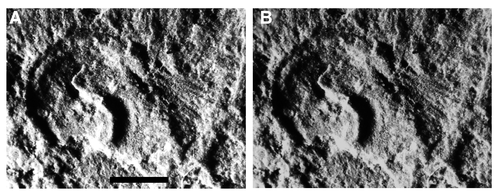
LSID
urn:lsid:zoobank.org:act:EBF3A682-007B-4BBB-9E8E-2EFB97659C83
Lectotype
USNM 90777A (Resser & Howell 1938, pl. 2, fig. 2), here designated.
Kinzers Formation, Emigsville Member, Cambrian Series 2, Stage 4. USNM locality 22L (Smithsonian file), 0.65 km south-east of the centre of East Petersburg, PA, USA. (40.0939763°N, 76.3471265°W).
Cotype
USNM 90777A (Resser & Howell, 1938, pl. 2, fig. 3).
Topotypes
NMNS, P-M-31a-f, 31h, 31j-o, 31q-r, from USNM locality 22L, immediately south-west of the intersection of Miller Road and Lake Drive (Fig. 3; 40.0939763°N, 76.3471265°W) in East Petersburg.
Newly referred material
USNM 617253p, 617253cp and USNM 617254p, 617254cp; Kinzers Formation, Emigsville Member, Cambrian Series 2, Stage 4. Locality SB, 223 Settlers Bend, at intersection with Buch Avenue, Manheim Township, about 6 km north of Lancaster, PA. (40.09495°N, 76.3217967°W). This is 2.3 km east of the type locality.
Original diagnosis
‘These tiny gastropods consist of simple whorls that expand rather rapidly.’ (Resser & Howell 1938).
Amended diagnosis
Whorl profile with a distinct angular bend between the periphery of apical surface of the shell and a depressed spire. Two clusters each of up to 50 chaetae, fan-like as compressed in the bedding plane and oriented obliquely forward, project far beyond the left and right margins of the aperture.
Description
Dextrally coiled helical shells of 1.5–2.5 whorls, with anterior–posterior dimensions and breadths, including chaetae, of about 2 mm. Their whorl profile was approximately triangular, expanding rapidly from a weakly concave (depressed) apical region (Fig. 6E), generating the relatively very large aperture typical of the genus. Evidence of the shape of the aperture is limited to a distinct angular bend between the apical and peripheral surfaces of the shell (Fig. 6D, E), also seen in the lectotype (Resser & Howell 1938, pl. 2, fig. 3). No indication of any sinus or auricle is preserved in our material, the types of Resser & Howell (1938), or topotypes we have examined. But, since the shells have been dissolved away and preserved as composite internal and external moulds that have been severely compressed, these and other morphological details of the shell are very imperfectly known. However, associated with the apertures of shells in our new assemblage from Settlers Bend are two clusters of anterior/lateral chaetae (Figs 2B, 6), shown by three-dimensional preservation of two of their bases (Figs 2C, 7) to have been expandable in life as conical arrays.
Remarks
Resser & Howell (1938) based Pelagiella exigua on two specimens from USNM locality 22L in the Emigsville Member of the Kinzers Formation, in East Petersburg, Pennsylvania. They assigned a single number, USNM 90777, to ‘a fairly well preserved example’ and an ‘impression’. The original description of this species is inadequate to distinguish it from others in the genus, and no such comparisons were made by its authors. Our observations of new material indicate the occurrence in this species of a pair of clusters of chaetae, not so far recorded in any species of Pelagiella. Our material is not from the type locality of P. exigua. It is from a site in Manheim Township that is close to the same horizon in the Emigsville Member of the Kinzers Formation, about 2.3 km along strike. On this account, it seemed likely but not certain that our new material is conspecific with P. exigua. Now we have recognized a single topotype specimen of P. exigua (NMNS, P-M-31 m) from locality 22L (East Petersburg), that also has chaetae preserved (Fig. 13). Thus, the identity of species found at the two localities is confirmed.
P. exigua differs from the type species of Pelagiella in that none of the known material shows evidence of gerontic thickening of the shell margin, the rounded whorl profile, or the much greater size achieved by P. atlantoides (Matthew).
Pelagiella exigua may be differentiable on shell characters from P. primaeva (Billings 1871), which occurs in strata of similar age in the northern Appalachians. Topotype specimens of P. primaeva that we have studied (BR) show it to have a flat upper whorl profile. This is consistent with the original description, ‘inner whorl scarcely elevated above the outer’ of Billings (1871, p. 220), and stands in contrast with the distinctly depressed spire of P. exigua. But no shell surfaces or impressions of P. exigua are available to compare its ornament with the reticulated pattern of fine striae and growth lines that is characteristic of P. primaeva (Walcott 1886). Now, however, P. exigua differs from P. primaeva, and from all other described species of Pelagiella, in that it is known to have had a pair of chaeta-bearing appendages.
Phosphatic steinkerns of Pelagiella sp. (Fig. 1A) have been described from beds transitional between the underlying Vintage Formation and the Kinzers Formation in a quarry near Thomasville, about 50 km west-south-west of Lancaster (Skovsted & Peel 2010).
These steinkerns have a prominent, near right-angle bend between the apical and peripheral surfaces of the whorl, like that observed on the lectotype of P. exigua, and the spire is deeply depressed (Fig. 1A). Skovsted & Peel (2010) noted similarity in form between these steinkerns and P. primaeva. However, they opted to leave them in open nomenclature, citing the difficulty of assigning steinkerns to species of Pelagiella. It seems likely that these steinkerns may be conspecific with P. exigua, a hypothesis that can be tested by finding well preserved steinkerns of P. exigua or evidence of chaetae in association with shells of Pelagiella at Thomasville.
Our recognition of paired clusters of chaetae as a so far unique, evolutionarily significant character of P. exigua should not be taken to imply that this feature did not occur in other species of Pelagiella. We advance the hypothesis that paired clusters of chaetae are likely to have been present in other species of Pelagiella. If this inference is correct, the singular occurrence of chaetae in P. exigua is an outcome of taphonomic processes unique to fossil Lagerstätten such as horizons within the Emigsville Member of the Kinzers Formation (Holmes et al. 2018), where preservation of refractory organic tissues such as chaetae was facilitated.
It is notable that sites of attachment of the clusters of chaetae observed in P. exigua coincide with left-lateral protrusion of the shell margin (the auricle) and a less clearly demarcated sinus on the right-hand side of the body in species such as P. subangulata. This prompts the further hypothesis that these aspects of the shell relate to functioning of the chaetae, which appears to have been accompanied by widely varying degrees of modification of the apertural margin, among individuals and species of Pelagiella, at their sites of operation.
Acknowledgements
We are grateful to J. Vinther for substantial collaboration in early work on this project, making key observations, taking most of the photographs, and sharing his ideas. We warmly thank C. de Wet, D. Erwin, D. Lindberg, A. Nützel, J. Peel, K. Peterson, J. Pojeta, M. Smith and P. Wagner for fruitful discussion and/or constructive comments on draft manuscripts; D. E. G. Briggs for making photographic equipment at Yale University available for our use; A. P. de Wet for drafting Fig. 3; M. Coppolino for drawing Fig. 9C; R. Secor for assistance with computer graphics; and Mr P. J. Mehta and Dr P. Mehta for permission to study fossils collected on their property and to deposit them at the US National Museum of Natural History. We warmly thank G. Budd, M. Sutton, G. Vermeij, an additional reviewer, and especially J. Sigwart for detailed editorial recommendations that have led to very substantial improvements in this paper. R. D. K. Thomas is grateful to Franklin & Marshall College for direct and indirect financial support of this work. He dedicates his contribution to this paper to the memories of J. Pojeta, R. M. Linsley and E. L. Yochelson.
Author contributions
RDKT did most of the research and wrote the original manuscript. BR provided valuable information and advice throughout the enterprise, collaborating extensively in shaping key illustrations and the final drafts. KM found the new fossils, made them available for study, and contributed his insights on their occurrence in the field and potential significance.



